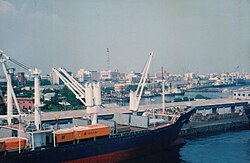Chennai Port
|
Chennai Port சென்னை துறைமுகம் |
|
|---|---|

Chennai Port in 1996
|
|
| Location | |
| Country |
|
| Location | Chennai (Madras) |
| Coordinates | 13°05′04″N 80°17′24″E / 13.08441°N 80.2899°ECoordinates: 13°05′04″N 80°17′24″E / 13.08441°N 80.2899°E |
| Details | |
| Opened | 1881 |
| Operated by | Chennai Port Trust |
| Owned by | Chennai Port Trust, Ministry of Shipping, Government of India |
| Type of harbor | Coastal breakwater, artificial, large seaport |
| Size of harbor | 169.97 ha (420.0 acres) |
| Land area | 237.54 ha (587.0 acres) |
| Size | 407.51 ha (1,007.0 acres) |
| Available berths | 26 |
| Employees | 8,000 (2004) |
| Chairman | Raveendran P IRTS (since 2016) |
| Main trades | Automobiles, motorcycles and general industrial cargo including iron ore, granite, coal, fertilizers, petroleum products, and containers Major exports: Iron ore, leather, cotton textiles Major imports: Wheat, raw cotton, machinery, iron & steel |
| World Port Index Number | 49450 |
| UN/LOCODE | INMAA |
| Statistics | |
| Annual cargo tonnage | 52.54 million tonnes (2014–15) |
| Annual container volume | 1.55 million TEUs (2014–2015) |
| Annual revenue | ₹ 8,904.0 million (2007–08) |
| Vessels handled | 2,181 (2010–2011) |
| Capacity |
Cargoes: 55.75 million tonnes (2008–09) Containers: 2 million TEUs |
|
Website www.chennaiport.gov.in |
|
Chennai Port, formerly known as Madras Port, is the second largest container port of India, behind the Nhava Sheva Port, and the largest port in the Bay of Bengal. It is the third oldest port among the 12 major ports of India with official port operations beginning in 1881, although maritime trade started much earlier in 1639 on the undeveloped shore. It is an artificial and all-weather port with wet docks. Once a major travel port, it become a major container port in the post-Independence era. The port remains a primary reason for the economic growth of Tamil Nadu, especially for the manufacturing boom in South India, and has contributed greatly to the development of the city. It is due of the existence of the port that the city of Chennai eventually became known as the Gateway of South India. The port has become a hub port for containers, cars and project cargo in the east coast of India. From handling a meagre volume of cargo in the early years of its existence, consisting chiefly of imports of oil and motors and the export of groundnuts, granite and ores, the port has started handling more than 60 million tonnes of cargo in recent years. In 2008, the port's container traffic crossed 1 million twenty-foot equivalent units (TEUs). It is currently ranked the 86th largest container port in the world and there are plans to expand the capacity to about 140 million tonnes per annum. It is an ISO 14001:2004 and ISPS-certified port and has become a main line port having direct connectivity to more than 50 ports around the world.
Although the settlement of Madras did not form until after the mid-17th century, the region surrounding the present-day port remained an important centre for military, administrative, and economic activities since the 1st century AD under various South Indian dynasties, namely, the Pallava, the Pandya, the Chola and the Vijayanagara empires. Chief among them was the Pallava dynasty, which reigned from the 6th to 9th centuries AD. The ancient town of Mylapore, known to Roman traders as "Meliapor", was an important port of the Pallavas and is now part of Chennai.
The region also attracted many distant civilisations, with the Christian apostle St. Thomas having preached in the area between 52 and 70 AD. In 1522, the Portuguese built the São Tomé harbour, named after St. Thomas, on the site of today's port and the São Tomé church on the grave of Saint Thomas. The following years saw the arrival of other Europeans, namely, the Dutch arriving at Pulicat in 1613 and the British arriving in 1639. In 1639, the British East India Company bought a three-mile long strip of land lying along the coast between the Cooum delta and the Egmore River encompassing an area of about five square kilometres from the Vijayanagara King Peda Venkata Rayalu. Soon obtaining permission from the regional ruler, Damarla Venkatadri Nayakudu, the British built a warehouse and factory on the site, and in 1940, the British expanded the occupation by building the Fort St. George and establishing a colony on the site of the future port of Madras.
...
Wikipedia
